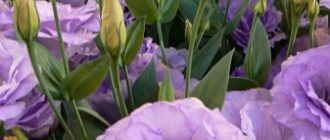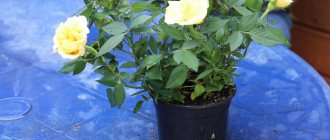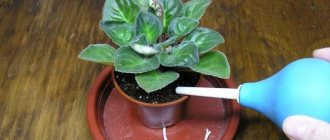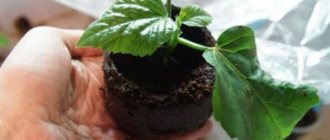Author's rating
Author of the article
Yakov Pavlovich
Professor, Head of the Department of Vegetable Growing
Articles written
153
Dwarf varieties of roses are successfully grown by gardeners in their gardens, houses and apartments. Miniature bushes are characterized by a long flowering period and varied bud colors.
With proper care and agricultural technology, the Cordana rose variety pleases with lush flowering from mid-spring to late autumn. But we’ll look into the details further on how to properly grow a flowering shrub.
Selection and description
The Cordana variety was obtained by selecting dwarf varieties of tea roses brought from China at the beginning of the 19th century.
The author of the new potted plant is the famous flower breeder Wilhelm Cordes, in whose honor the miniature rose got its name.
The compact rose flower bush is demanding in terms of growing conditions and care. Therefore, before growing Cordana roses, you must carefully read the detailed description of the plant.
- Mature bushes are small, reaching a maximum height of 25-30 centimeters.
- The plant is covered with dark green leaf blades, the shape and structure characteristic of this crop.
- The period of rapid flowering begins in mid-spring and continues until the end of autumn.
- The buds are of a standard shape and structure, the color is varied, depending on the variety and variety of the plant.
Reference! Miniature roses take root well at home and in the open ground of gardens and summer cottages. Used for planting flower beds, flower borders and creating landscape design in personal plots.
Common growing questions
- keeping the flower in inappropriate conditions;
- it is possible that the rose is pruned incorrectly, after which flowering will not occur;
- Excess nitrogen fertilizer can also cause a lack of buds.
The Cordana mix variety, although difficult to care for, still allows you to grow beautiful bushes with an abundance of small flowers of different shades in the house and garden. You can use a flower to decorate not only the interior, but also the outdoor area.
Rosa Cordana is a miniature sized rose. It can be a decoration not only for a summer cottage. With the same success, it can be grown at home, in an apartment. Looks great in large flowerpots and ceramic pots on the windowsill. The Kordana rose reaches 30 cm in height. Long-term flowering: from May to October.
The foliage of the plant is bright green. In combination with buds of a classic rose shape, in different shades, it looks simply magnificent.
Caring for the Cordana rose should be the same as for the rest of the rose family. By creating suitable conditions for the plant, growing a flower will bring a lot of positive emotions.
Miniature Cordana Rose
Varieties of varieties and color variations
Thanks to the fruitful work of breeders, many varietal varieties of miniature roses were obtained.
- The Mix variety is resistant to weather changes and easily takes root in open ground and at home. Multi-colored buds open in early May and bloom until the end of October.
- Cordana variety Mini Caliber blooms with small flowers in bright orange and red shades. Flowering is abundant and continues until the first frost.
- The Pasadena variety is resistant to diseases and harmful insects. During the flowering period, burgundy and dark red buds bloom on the plants.
- The lush flowers of the dwarf rose variety Ballet are shaped like a ballet tutu and painted in a bright coral color.
- Cordana variety Pearl blooms with multiple flowers in cream or white shades.
- The Kiss rose is characterized by excellent resistance to low temperatures and blooms with burgundy or red flowers.
Also resistant to weather changes is a rose with soft apricot flowers called Impala. And the Magnolia variety is characterized by cream flowers and bright green edging around the edges.
Expert opinion
Stanislav Pavlovich
Gardener with 17 years of experience and our expert
Ask a Question
Important! Each varietal variety of Cordana rose has its own requirements for growing conditions and care.
Preparing for winter
The best covering material for roses is snow. Nature came up with the best. Who would have thought, but it is so. Snow retains heat better than any synthetic material and protects plants from frost. As soon as the first snow has fallen, you need to collect it in a pile and cover the roses with it.
A good option for covering material is spruce branches. It can be successfully used both under roses, from below and above, protecting plants from the cold. In this case, a large amount of material will be required; this must be taken into account in advance so that there is enough for all the bushes.
Another natural material is spruce sawdust. They are used to cover the entire surface of the bush. You can wait out the winter without worrying about your roses.
Another alternative for covering material is leaves. There is an important point here: the leaves must be absolutely healthy. You can collect leaves to cover roses only in dry weather.
The simplest and most unpretentious solution is to go to a specialized store and purchase covering material.
Rose Cordana mix is a beautiful variety of roses. The requirement for care lies only in compliance with care measures: moderate watering, fertilizing, pruning. This type of rose is frost resistant. Proper, careful care of the plant will definitely lead to flowering.
Rose "Cordana" is well known to lovers of indoor plants and is successfully grown both in pots and in open ground as a border decoration. The popularity of the flower is due to its high decorative qualities and unusual miniature size.
Features of roses and advantages of growing
The main feature of the Cordana rose is its complete lack of aroma. For many, this property of the plant is a disadvantage. But for people prone to allergic reactions, growing such a flower will bring a lot of joy and pleasure.
See also: Care and cultivation of climbing roses in open ground
Before growing a miniature rose, you need to find out all the pros and cons of the plant.
Advantages:
- long flowering period;
- if comfortable conditions are created, flowering of bushes is possible in winter;
- lack of aroma, which allows you to grow roses if you are prone to allergies;
- large selection of color shades;
- the possibility of growing rose bushes in open ground and at home.
The main disadvantage of the culture is that plants are demanding in terms of growing conditions and care.
Further care in open ground
Rose Cordana feels great in open ground: it grows well and develops. Once it has reached the desired size in the pot, it can be transplanted into open soil in the garden.
The rules of care are very simple: timely watering and fertilizing in preparation for flowering. Pruning of bushes occurs in the autumn. This is required for a good winter. In the absence of these procedures, flowering may not occur.
Note! The soil should be fertilized first, before the flower itself is planted. Pour ash or manure into a hole prepared in advance, and only then plant a flower. Watering occurs only with warm water.
The soil must be constantly weeded and weeds removed so that the soil can breathe.
During wintering, it is recommended to make a reliable shelter for it, for example, move it to a greenhouse.
Indoor Cordana grows and develops well in open ground; it can be planted in the garden or flowerbed. Experts recommend planting plants that have reached the age of 3 or more years.
The process of growing Cordana in gardens and flower beds is not much different from caring for it indoors. The plant needs to be provided with certain conditions:
- the location is western or southwestern, with sufficient light, but without direct sunlight, especially in the hot summer months;
- timely watering, while the soil should not dry out;
- spraying foliage in the evening, especially at temperatures above 25 degrees;
- constant loosening of the top layer of soil;
- the soil composition should be nutritious, but not very dense; add peat if necessary;
- in the summer months, it would be a good idea to mulch the soil to prevent overheating of the roots;
Planting in open ground - stagnation of water is unacceptable at any time; if you notice it, you should immediately reduce the number of waterings;
- use of fertilizing several times during the growing season;
- removing weeds as they appear;
- pruning the bush in the fall after flowering to maintain shape and ensure successful growing season for the next season.
The bushes will grow comfortably near other plants, since the roots of the rose are small and require little space. The main thing is a sufficient amount of nutrients in the soil and timely watering.
Shelter for the winter
When growing a mini-rose in open ground, you need to prepare it for the winter cold and help the plant survive it. Preparation for frost should consist of several stages:
- Pruning the bush in autumn to a height of 10-15 cm.
- Hilling up the bush with compost.
- Covering with natural materials (spruce branches, sawdust, leaves) or film, plastic bottles.
If it is not possible to transplant the rose into a greenhouse before spring, it is necessary to cover it for the winter, since the flower will not be able to survive a frosty winter without these measures.
Requirements for growing conditions
For growth and abundant flowering, a miniature rose requires suitable conditions and careful, timely care. Otherwise, the plant will get sick, lose leaves and wither.
Location and lighting of the place
For full growth and development of the flower, choose well-lit rooms. This variety of rose blooms best on south-facing windowsills.
The bush requires a lot of sunlight, but direct rays can cause burns on the leaf blades. Therefore, the place where it is planned to grow the rose is slightly shaded.
Expert opinion
Stanislav Pavlovich
Gardener with 17 years of experience and our expert
Ask a Question
Advice! In winter, an additional light source is placed next to the plants.
Temperature and humidity
The flower does not tolerate drafts, sudden temperature changes and dry air. Flowerpots with plants should not be placed next to heating appliances.
For active growth and development, the plant requires a temperature of +15 to + 20 degrees and high air humidity.
To create the necessary microclimate, the room and flower are sprayed weekly with a spray bottle.
To reduce the number of irrigation activities, place a container of water next to the flowerpot or use a humidifier.
Pot, soil and drainage
To grow roses, purchase spacious flower pots or flowerpots.
- Holes are made at the bottom of the container to drain excess moisture.
- The pot is thoroughly washed with laundry soap.
- A drainage layer of small stone is laid on the bottom.
- You can buy soil mixture for the plant at flower shops or make it yourself. To do this, garden soil is mixed with humus and river sand.
Advice! To prevent the development of pathogens and harmful insects, the resulting fertile soil mixture is scalded with boiling water or heated in the oven.
Purchase and adaptation
When going to a flower shop, many are sure that all the flowers are of high quality, but this is not always the case. You need to know the specifics of choosing a plant so that you don’t waste energy and additional funds on restoring the flower if problems arise.
- Carefully examine the bush you like. Its leaves should be dark green, shiny and firmly attached to the stem.
- The presence of a white coating on the leaf blades indicates that the plant is affected by powdery mildew.
- Leaves with black or brown spots - the rose was not cared for correctly, it got a fungal infection.
- The leaves turn yellow and fall off - the plant is exhausted or the soil is too wet.
Important! It is better not to purchase such flowers, as they will bring a lot of trouble, and there is no guarantee that the plant will fully recover.
Rosa Cordana is sensitive to changes in environment. Often a flower brought home can suddenly lose its leaves. This indicates that the bush is weakened and needs care.
To prevent such a reaction to a new place, a rose brought into the house needs to:
- free from packaging material;
- wash under a warm shower (will help get rid of spider mites);
- treat with insecticides against other pests.
After these procedures, place the rose in a suitable place.
What care is required after purchase
Purchase a dwarf plant from trusted retail outlets. The flower is carefully examined for disease, pests and damage.
- The green cover of the rose should be uniform, the leaf plates are firmly connected to the branches.
- Absence of any stains, plaques or signs of rot on the leaf plates.
- Also, there should be no signs of yellowing or wilting on the leaves.
- The soil in the pot is moderately moist.
The plant has a hard time with changing its place of permanent residence. Therefore, after purchase, the bush is generously sprayed with warm, settled water and treated with remedies against diseases and harmful insects.
After the procedures are completed, the plant is sent to a prepared place for further adaptation.
Varieties
Mini-rose "Cordana" has several subcultivars intended for both home and border cultivation.
- “Mix” is the smallest representative of the species and is only suitable for indoor breeding. It is considered the most capricious of all subvarieties, as it requires the creation of especially favorable conditions. The plant owes its name to its variety of colors, which is why it has become very popular among amateur gardeners.
- “Lux Denmark” is distinguished by compact bushes and soft purple flowers mixed with raspberry shades.
- "Gigi" is characterized by red and white flowers and, with proper care, can reach a height of more than 30 cm.
- "Amore" is intended for cultivation in open ground and is distinguished by tall bushes growing up to 40 cm.
- 'Apollo' has soft yellow flowers and can bloom for up to 20 weeks.
- "Pasadena" is a classic rose in miniature, and is characterized by increased resistance to fungal diseases.
- “Caliber” is characterized by miniature red flowers measuring 2-3 cm, which bloom until the onset of cold weather.
All varieties of Cordana roses are quite demanding to care for, requiring the creation of special conditions. When growing a flower at home, it is necessary to take into account many important factors and perform a number of mandatory procedures.
Accommodation
Immediately after purchase, the plant must be washed with warm water and sprayed with a pest control solution. It is better to place the flower on windows facing south or southwest, and this must be done in such a way that during the daytime it is moderately shaded by other plants. Exposure to direct sunlight, especially in summer, is unacceptable. The recommended air temperature is +15.20 degrees.
Watering
Rose "Cordana" needs weekly watering with warm, settled water. When using cold tap water, the plant may develop powdery mildew, an ailment that will be very difficult to cure. Watering should be quite abundant, with the obligatory removal of excess liquid from the pot. Otherwise, the rose may not bloom. In summer, the plant needs slightly more frequent watering, the need for which is determined by the dried out top layer of soil. During watering, it is recommended to lightly loosen the soil, which ensures the flow of oxygen to the roots of plants and improves air exchange.
If you need to leave for a long time, it is recommended to pour a sufficient amount of water into a deep tray and place pots of roses in it. Plants can feed in this way for one to one and a half months. In addition to watering, it is recommended to spray the flowers weekly using settled water at room temperature.
Top dressing
The application of mineral and organic fertilizers is carried out twice a year, taking into account the growing seasons of plants: during flowering and the appearance of ovaries, fertilizing is not done. The optimal time for feeding is spring and autumn. In the spring, it is performed before flowering begins, and the main emphasis is on nitrogen-containing fertilizers. They promote abundant growth of green mass and activate flowering.
Features of keeping at home
For active growth and abundant flowering, the rose requires proper watering, additional nutrition and timely formative pruning of the bush. Also, the soil under the plant is loosened and freed from weed roots and grass.
Watering and spraying
The miniature flower grows best in fertile, well-moistened soil. Water the rose as the top layer of soil dries. After irrigation activities, the soil is thoroughly loosened.
In winter, heating quickly dries out the air. To prevent the flower from being damaged, the room is sprayed with water from a spray bottle.
See also: Autumn and spring transplanting roses to a new place
Fertilizer
The Cordana rose variety is fed throughout the growing season. For feeding, a mineral complex based on potassium and phosphorus is used. Fertilizing of a home plant is carried out once every 10-12 days.
Bush formation and pruning
Activities for pruning and shaping the bush are carried out after the end of the flowering period. Weak, dried and underdeveloped shoots are removed from the bush.
The remaining branches are pruned, leaving 2 to 4 buds on the shoots.
Rest period
Wintering for roses of the Cordana variety takes place in a dormant state. In order for the plant to rest and gain strength for further flowering, the temperature in the room is lowered to +8 degrees.
Some varietal varieties of the flower can bloom in winter. To do this, plants are provided with the necessary microclimate and additional lighting.
Transfer
2-3 days after purchase and adaptation to a new location, the plant is replanted. Planting is carried out in previously prepared containers with fertile soil.
- The flower is watered generously with warm water.
- The bush is carefully removed from the old pot along with a lump of earth.
- Next, the plant is placed in a new container, sprinkled with soil on top and watered.
The same actions are carried out for further transplantation of the flower into pots and vases of larger volume.
How to replant rose Cordana mix
To reduce the need to disturb the root system, you need to place the rose in a new container along with the soil. If there are several roses, you need to act differently:
- A pot with drainage holes is selected, pebbles are lined at the bottom as drainage, the top is covered with soil mixed with nutrients, and pure soil is added on top of this layer. A seedling is planted on this soil.
- The soil should be compacted tightly and immediately watered with water at room temperature. Leave a distance of 2 cm between the edge of the pot and the surface of the soil.
Landing in the ground
Diseases and pests of crops
Improper care and agricultural practices increase the risk of fungal, viral and bacterial infections of the plant.
- Rust on bushes appears as red spots on the leaves. The disease spreads quickly and affects the plant. If treatment with fungicides is not started in time, the flower dies.
- Powdery mildew also affects the green cover and buds of the plant. For prevention and treatment, professional preparations based on fungicides are used.
- Rapid wilting of foliage and the appearance of dark spots warns of black spot. Fungicides are also used to treat plants.
To protect your home flower from attack by harmful insects, plants are treated with insecticides.
Reproduction methods
Dwarf roses are propagated by cuttings. Shoots are cut from an adult flower at an angle of 45 degrees. The procedure can be carried out at any time during the growing season. Next, the cutting is placed in a container with water and a growth stimulator, covered with film or a plastic bottle. After the roots appear, the cuttings are transferred to a pot with fertile soil.
Expert opinion
Stanislav Pavlovich
Gardener with 17 years of experience and our expert
Ask a Question
Important! Cuttings are trimmed with a sharp, thoroughly disinfected manganese solution using pruning shears or a garden knife.
Advice from experienced gardeners
In summer and spring, it is better to take the rose out onto the balcony. At the same time, you should definitely make sure that it is not exposed to direct sunlight and that the pot itself does not overheat. To do this, it is placed in a white pot or wrapped in foil. This will protect the roots from overheating.
In summer and spring, it is better to take the rose out onto the balcony.
When pruning, not only branches should be removed, but also flowers if they have wilted. Cut off the wilted bud to the first bud. Don't wait for the bud to completely wither. The first signs of wilting should be a signal for removal, otherwise the plant will waste energy on forming seeds, and this should not be allowed.
Fertilizers are applied to the surface of the rose and under the roots.
If a rose is purchased when it is not blooming or is just beginning to bloom, it is better to replant it immediately.
Important! It is important to constantly maintain the soil in the right condition. It must be well moisturized, as this is the key to the longevity of the rose.
The rose is propagated by cuttings, which can be taken from May to August. The optimal shoot thickness is 2.5 - 3.5 mm. The cuttings are placed in a transparent glass of water (3 cm). They will take root within a month. They are transplanted into a pot when the roots reach 1.5-2 cm in length. For the first days, it is better to keep the pot with newly transplanted cuttings away from direct sunlight.
Note! When placing the cutting in a glass of water, it is better to add the drug heteroauxin, which stimulates root formation.
If you follow all the rules and carefully care for the Cordana rose, it will please the eye for many years. This indoor perennial plant can live from 5 to 15 years.











